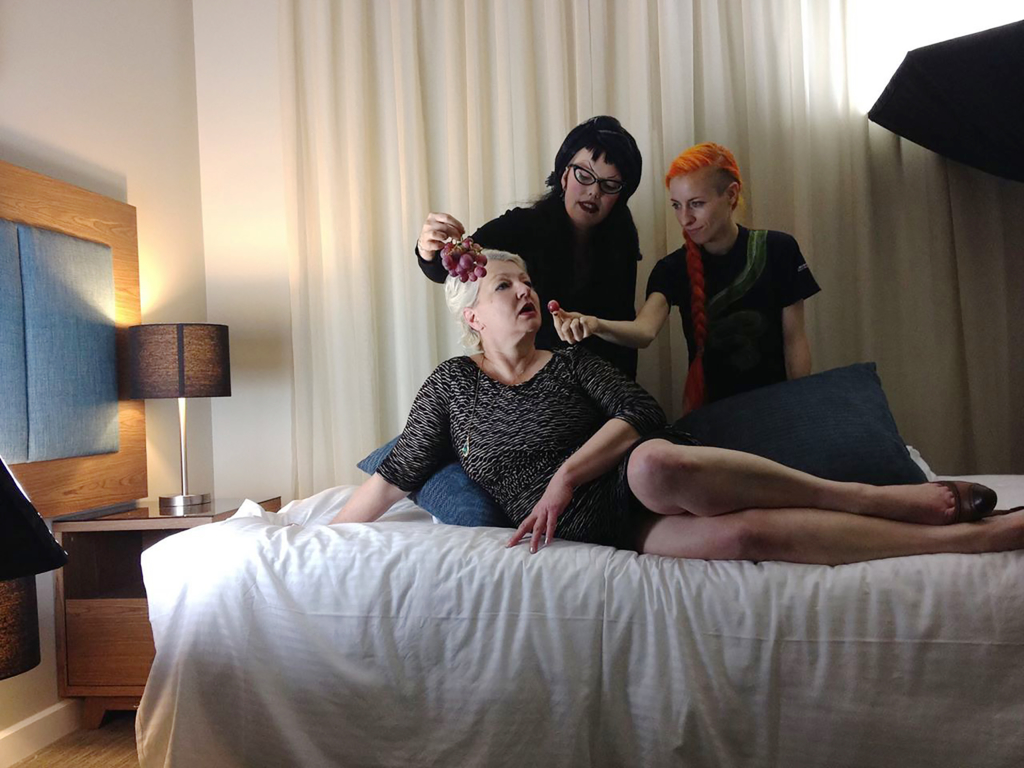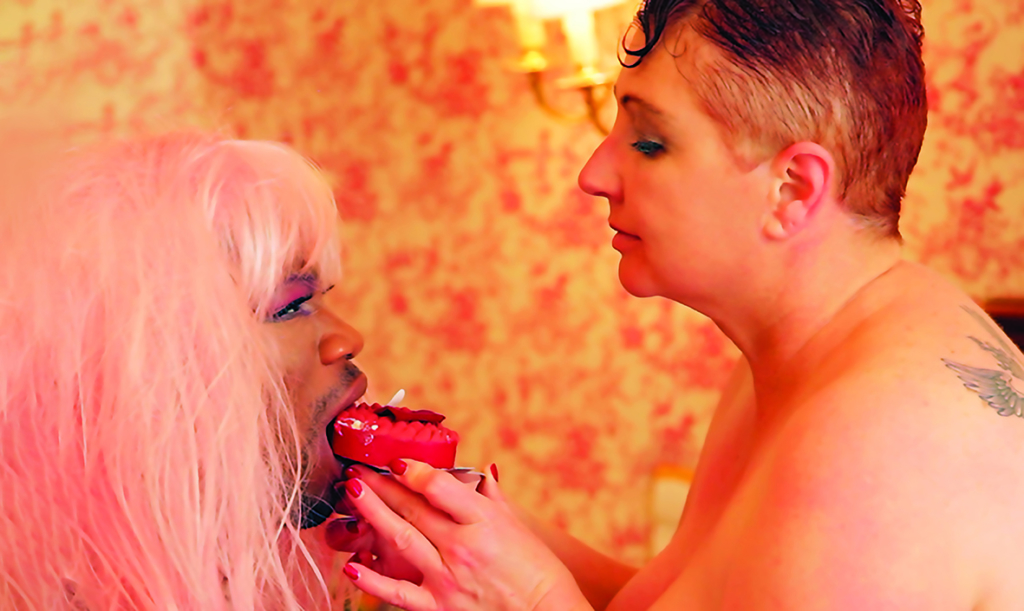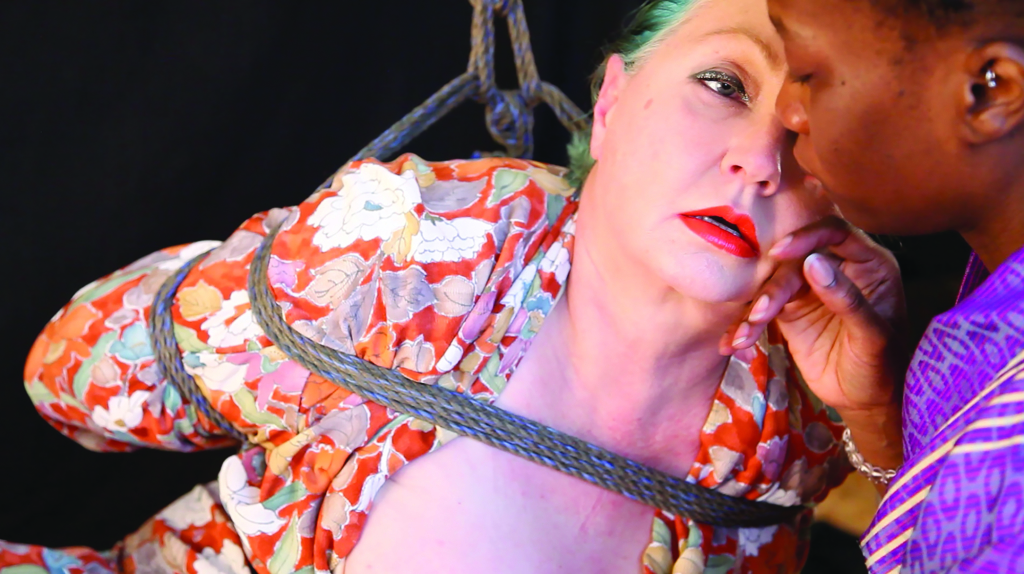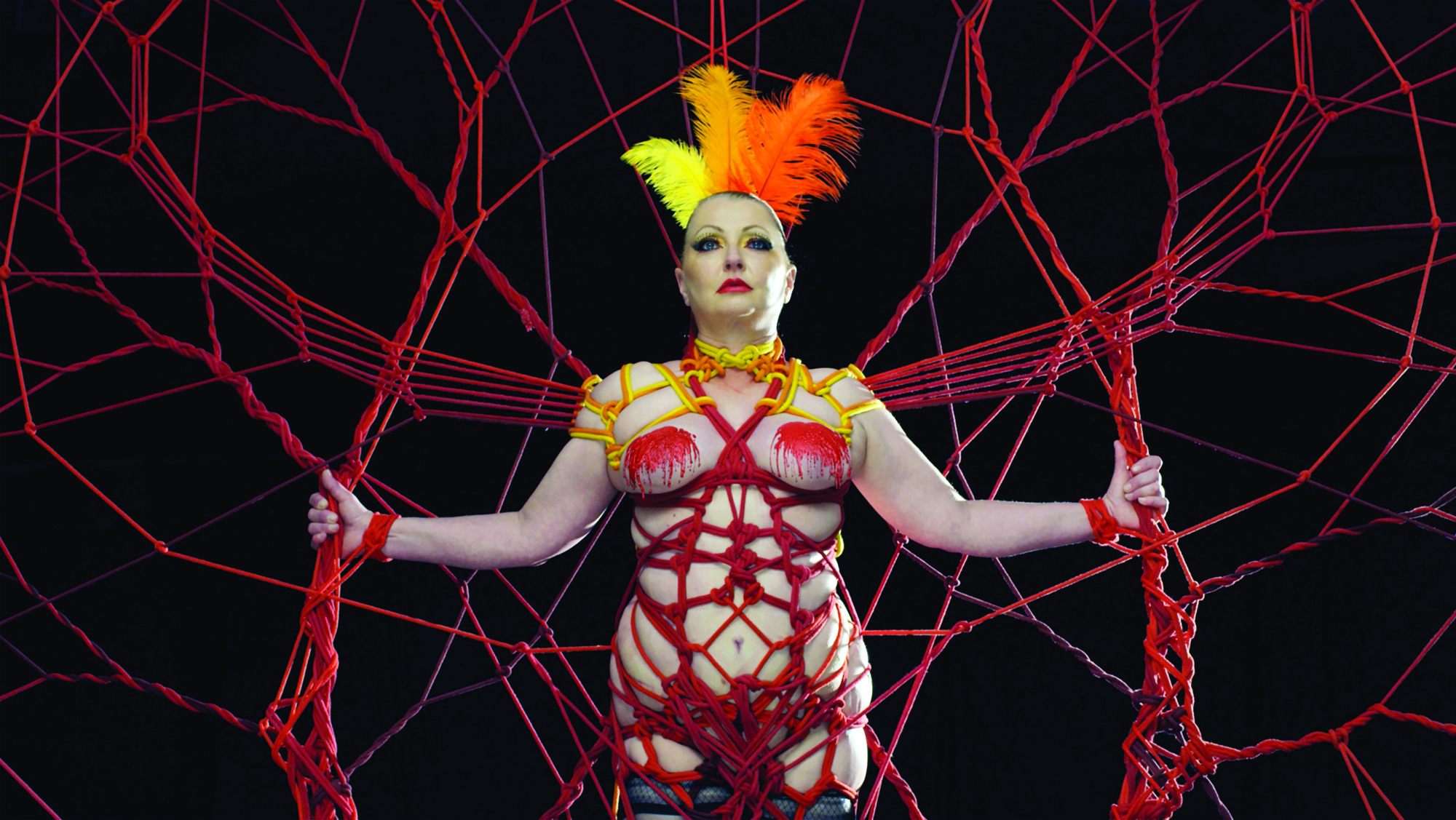Morgana (Isabel Peppard & Josie Hess, 2019) recounts the true story of a middle-aged, clinically depressed housewife who reinvents herself into an internationally award-winning auteur known as ‘Morgana Muses’. Boundary-pushing and explicit – and this documentary is certainly explicit – it seems, at first, to be a fairly classic narrative of self-actualisation: an inspiring feminist liberation story with a sex-positive, age-positive heroine. But, over several years of filming, and through close, respectful collaboration with their subject, Peppard and Hess succeed in painting a much more nuanced portrait, one with an important mental-health message: that real life and real art require repeated transformations and reinventions – or even rebirths – especially when the cycles of bipolar disorder are involved.
The film opens with Morgana walking into Australian bushland, scouting for a location. Wearing spectacles and jeans and carrying a clipboard, she’s businesslike as she chats with her young, female cinematographer in sparkly red pants and bright pigtails. This happens to be Hess, a filmmaker who also works intimately with Morgana, shooting and editing the latter’s erotic films. Wandering through the bush, they’re looking for a hole to bury Morgana in. The mood is buoyant but nervous as she jokes that she doesn’t care what outfit she’s buried in, as long as it involves ‘gorgeous shoes’. Another woman, this time in head-to-toe gothic black, enters the picture and stands by the makeshift grave, hands on hips. ‘What kind of sprinkling do you want, Moggsie?’ she asks. This is Peppard, negotiating the exact manner in which Morgana wants dirt to be thrown over her face when filming begins.

The full significance of this macabre setup will only become evident later in the story, but by starting with this scene, the filmmakers, together with editor Julie-Anne De Ruvo, show their subject in charge of the action. She’s no ordinary actress or ‘exploited’ porn star but, rather, a creator giving life to her own visions. This authorship is reiterated in voiceover, with Morgana saying: ‘My ideas are so great and they sound so awesome when I’m typing them […] It’s like the film is already rolling in my mind.’
Despite the filmmakers’ presence in this opening scene and occasional appearances, especially by Hess, on the peripheries at other times, it’s Morgana’s image and voice that dominate every shot. She speaks in an Australian accent, sometimes with faint intonations of her Eastern European heritage. Her first-generation immigrant parents, she tells us, had a harsh life and wanted a dutiful daughter to bear the markers of success and respectability. And so she married and had two children, and lived in a big house with ‘all the fittings’ in the regional New South Wales (NSW) centre of Albury. By the time she was forty-five, she was divorced, lonely and suicidal.
This retelling is achieved through interviews to-camera, often filmed in extreme close-up with a focus on Morgana’s eyes, cheeks or lips, woven together with photos from her past. This standard documentary portraiture is intercut with dramatic landscape scenes (such as of the stark beauty of outback Coober Pedy, where her childhood was spent) and impressionistic miniature art installations superimposed onto other images or even inserted into the frame. We also see a black cut-out of a house facade; it’s cartoon-like, but with the real Morgana standing behind it, her eye peering through a window as if she’s a giant trapped in a grim fairytale.

Artistry of this calibre can be attributed to Peppard. Morgana may be her first documentary, but she’s an acclaimed animator, sculptor and artist, best known for her exquisitely handcrafted, multi-award-winning stop-motion animation short Butterflies (2012), and also for her technical work for filmmaker Adam Elliot (Mary and Max, 2009) and hyperreal conceptual artist Patricia Piccinini.
Artistic identity and the redemptive power of creative expression are key elements of Peppard’s work; Butterflies, for instance, is a fable about the importance of protecting the fragile muse and making art for art’s sake. These themes are also evident in Morgana’s story. The value of her work, both as she herself talks about it and as the filmmakers present it, is understood primarily outside the commercial realm. And it is likewise through creative expression that Morgana literally saves her own life, and finds a new identity and a series of warm, accepting communities.
An erotic film star is born
Morbidly obese and effectively celibate for much of her unhappy marriage, Morgana says she craved human touch. Feeling hopeless after the divorce, she planned to kill herself – but she also wanted one last hurrah, and hired a male escort. The way she tells it, this experience was a revelation. ‘Someone flicked the switch on and the power came on,’ she recounts in the film, still visibly stirred by the memory, though the reminiscence seems well rehearsed. This is a story she has re-enacted in her work and told many times, including at film festivals and on the website for her own business, Permission 4 Pleasure.[1]See Permission 4 Pleasure website, <http://permission4pleasure.com>, accessed 14 October 2019. We sense that she is first and foremost a performer, not just in her own films and in this documentary, but also in her life; in Morgana, she’s often seen playing up to the camera, coming alive to its gaze with a showgirl’s bravado. And, like all bravado, this masks a fragility – in her case, one connected with recurring episodes of depression and mania.

As part of her sexual awakening, Morgana says she began to look at ‘erotic imagery aimed at women’, and stumbled upon the work of German feminist porn veteran Petra Joy, who formerly presented an award for first-time female filmmakers who ‘dare to question porn clichés and show sex in innovative and creative ways’.[2]‘The Award’, Petra Joy Award website, archived at <https://web.archive.org/web/20090706053845/http://www.joyawards.com/index.asp>, accessed 14 October 2019. Inspired by Joy, Morgana then made a film about her life-changing experience with the aforementioned male escort, John Oh, who was happy to re-create the encounter on camera (and also, later, to participate in Peppard and Hess’ documentary). That erotic short film, Duty Bound (2012),won first prize at that year’s Petra Joy Awards; spurred on by this success, Morgana has gone on to make thirteen more short films, travelling the world and collecting awards at events like the Toronto International Porn Festival and CineKink NYC.
In Morgana, she’s often seen playing up to the camera, coming alive to its gaze with a showgirl’s bravado. And, like all bravado, this masks a fragility – in her case, one connected with recurring episodes of depression and mania.
Clips from Morgana’s films – which she writes, directs, produces and performs in – are woven liberally throughout the documentary. The first ‘erotic’ images we’re shown are in slow motion: brightly painted lips, beaded with sweat or something else; eyelids closed in performed ecstasy; stockings rolled over dimpled knees. But these are coy teasers, more reminiscent of a Mills & Boon novel than hardcore porn, and, like with any good tease, the filmmakers use these to build to a climax. That comes in the form of an outrageous scene from one of Morgana’s more recent works, Labia of Love (2018), involving extreme close-ups of the titular body part decorated with dripping paint, whipped cream and birthday candles.
Riding high: Ethical porn and female pleasure
Very early in the documentary, Morgana’s high status and celebrity within the alternative-porn community are established. A number of talking heads speak about the significance of her ‘memoiristic’ work and its very personal qualities that are ‘not the norm’, even within this experimental world. Of Morgana’s films, author and sex educator Eva Sless reflects: ‘It wasn’t porn as you know it to be. It was art […] It was the difference between a Penthouse spread and a [Sandro] Botticelli nude.’
The film insists, in multiple ways, that Morgana is more of an artist than a purely commercial pornographer, and we see her approach evolve over time – from employing traditional romance tropes and props (strawberries eaten off a bare belly, a whip made of feathers) to more experimental ideas relating to pleasure and sensuality (like sugary French cakes consumed with abandon, or bathtime breath-holding games with a same-sex lover). In fact, some of Morgana’s later works are much more concerned with exploring social issues than with sex.

Not just celebrated for her artistry, Morgana is also lauded for defying so many societal stereotypes of what a sexualised body should look like. Comedian Judith Lucy pipes in with admiration, bemoaning ‘the idea that, if a woman is over a certain age, well, then you’ve basically hung your vagina up on a wall!’ Instead, Morgana is sexually alive well into her fifties, and her naturally round body, scarred from surgeries and rapid weight fluctuations, is a world away from the silicone-enhanced physiques shown in many pornographic films. ‘She looks like somebody’s mum,’ says Anna Brownfield, a Melbourne feminist filmmaker who’s made porn and worked on some of Morgana’s movies. Peppard and Hess also show Morgana at a number of events receiving gushing praise from young women and even young men who have found her ‘inspiring’ and reassuring about the possibilities for life and sex after humans’ ostensible prime.
An emphasis on female pleasure is one of the distinguishing features of feminist or ethical porn (the terms are sometimes used interchangeably) involving women, differentiating it from the murky and exploitative world of mainstream porn. Essential, too, is the respectful treatment of those performing.[3]See Zoe Williams, ‘Is There Such a Thing as Ethical Porn?’, The Guardian, 1 November 2014, <https://www.theguardian.com/culture/2014/nov/01/ethical-porn-fair-trade-sex>; and ‘Ethical Porn: What It Is and Who Is Making It’, FeministPorn.org, <https://feministporn.org/ethical-porn/>, accessed 14 October 2019. As Peppard explained to screenhub in an interview before the film’s premiere at the 2019 Melbourne International Film Festival (MIFF), ‘It’s a different production model. Like with ethically sourced food, if you watch ethical porn, you know your porn stars have been treated well.’[4]Isabel Peppard, quoted in Rochelle Siemienowicz, ‘Death, Rebirth and the Feminist Porn Star’, screenhub, 13 August 2019, <https://www.screenhub.com.au/news-article/news/film/rochelle-siemienowicz/death-rebirth-and-the-feminist-porn-star-258485>, accessed 14 October 2019.
Pro-sex, pro-woman, pro-porn?
With one of its directors intimately involved in the production of the erotic films excerpted on screen, it’s no surprise that Morgana is unashamedly supportive of the pro-porn position that Joy asserts in an early to-camera interview, professing that women have a right to see erotic visuals and films, and that this is part of ‘a new kind of female-led sexual revolution’.
Morgana never directly explores the legality of pornography in Australia, but the topic was raised at a panel discussion following the film’s world premiere at MIFF by the famously sex-positive Victorian Legislative Council member Fiona Patten, founder of the Australian Sex Party and leader of its current incarnation, the Reason Party. Amid that evening’s celebration of the film’s progressive sexual politics, Patten reminded the audience that it would still be impossible for such a film to be legally shown in a regular cinema, outside of the classification exemptions enjoyed by film festivals.[5]Fiona Patten, in Morgana post-screening panel discussion, Melbourne International Film Festival, 16 August 2019.

The making and selling of pornography are illegal in Victoria and NSW,[6]See Jarryd Bartle, ‘Is Porn Legal in Australia’, Eros Association website, <https://www.eros.org.au/is-porn-legal-in-australia/>; and Australian Law Reform Commission, ‘Should All Adult Content Be Classified?’, 29 February 2012, <https://www.alrc.gov.au/publication/classification-content-regulation-and-convergent-media-alrc-report-118/10-restricting-access-to-adult-content/should-all-adult-content-be-classified/>, both accessed 14 October 2019. where Morgana has lived and produced her films. Due to its explicit subject matter, this documentary, unsurprisingly made entirely outside of government-funding schemes, will probably spend most of its existence on the specialist festival circuit. The fact the law lags so far behind widespread porn consumption in Australian society[7]See ‘Most Australians View Porn but Few Report Ill Effects: New Research’, The University of Sydney website, 27 July 2016, <https://sydney.edu.au/news-opinion/news/2016/07/27/most-australians-view-porn-but-few-report-ill-effects–new-resea.html>; and Matthew Dunn, ‘PornHub Has Published Statistics on How Australians Consume Porn’, News.com.au, 19 January 2015, <https://www.news.com.au/technology/online/social/pornhub-has-published-statistics-on-how-australians-consume-porn/news-story/b795635e5fc0dfb1751926d22e1eac57>, both accessed 14 October 2019. was underlined in the Victorian Parliament in September this year: Liberal Democrat politician Tim Quilty gave a cheeky speech directly referencing Morgana and calling for changes to legislation around pornography to ‘make Victoria sexy again’.[8]See Tim Quilty MLC official page, Facebook post dated 13 September 2019, <https://www.facebook.com/watch/?v=2427075660707958>, accessed 14 October 2019.
Crash, burn, reborn
Arguably, some of the most disturbing scenes in the documentary come from one of Morgana’s short films that is not about sex at all: The Life of Bi (2016), self-described as a work ‘about living with mental illness’. The short’s on-screen intertitles suggest that Morgana ‘wanted to show how it feels just trying to keep [her] head above water’.[9]The Life of Bi can be viewed in full on YouTube at <https://www.youtube.com/watch?v=Ite1TQSUfLw>, accessed 14 October 2019.
With her head grotesquely covered in a tight stocking, she slashes at her face with vivid red lipstick, and talks candidly about her self-loathing and periodic withdrawals from life. We see her in bed surrounded by junk food, and overlaid onto these scenes in the documentary, we hear her voice on the phone begging Hess to reassure her that life is still worth living. Then we return to those early scenes from the bush grave as they appear in The Life of Bi, finally seeing Morgana rise out of the hole, covered in dirt. She is a survivor who has journeyed through many incarnations of her self to accept her sexual desires, her body and, finally, her mind, in all its creativity and fragility.
Morgana tells an inspiring story – but it’s also a realistic one. Good editing can create a tidy and uplifting conclusion, but, if Morgana has shown us anything in her own films, as well as in this documentary, it’s that self-acceptance, creative expression and managing one’s moods are all lifelong endeavours.
Endnotes
| 1 | See Permission 4 Pleasure website, <http://permission4pleasure.com>, accessed 14 October 2019. |
|---|---|
| 2 | ‘The Award’, Petra Joy Award website, archived at <https://web.archive.org/web/20090706053845/http://www.joyawards.com/index.asp>, accessed 14 October 2019. |
| 3 | See Zoe Williams, ‘Is There Such a Thing as Ethical Porn?’, The Guardian, 1 November 2014, <https://www.theguardian.com/culture/2014/nov/01/ethical-porn-fair-trade-sex>; and ‘Ethical Porn: What It Is and Who Is Making It’, FeministPorn.org, <https://feministporn.org/ethical-porn/>, accessed 14 October 2019. |
| 4 | Isabel Peppard, quoted in Rochelle Siemienowicz, ‘Death, Rebirth and the Feminist Porn Star’, screenhub, 13 August 2019, <https://www.screenhub.com.au/news-article/news/film/rochelle-siemienowicz/death-rebirth-and-the-feminist-porn-star-258485>, accessed 14 October 2019. |
| 5 | Fiona Patten, in Morgana post-screening panel discussion, Melbourne International Film Festival, 16 August 2019. |
| 6 | See Jarryd Bartle, ‘Is Porn Legal in Australia’, Eros Association website, <https://www.eros.org.au/is-porn-legal-in-australia/>; and Australian Law Reform Commission, ‘Should All Adult Content Be Classified?’, 29 February 2012, <https://www.alrc.gov.au/publication/classification-content-regulation-and-convergent-media-alrc-report-118/10-restricting-access-to-adult-content/should-all-adult-content-be-classified/>, both accessed 14 October 2019. |
| 7 | See ‘Most Australians View Porn but Few Report Ill Effects: New Research’, The University of Sydney website, 27 July 2016, <https://sydney.edu.au/news-opinion/news/2016/07/27/most-australians-view-porn-but-few-report-ill-effects–new-resea.html>; and Matthew Dunn, ‘PornHub Has Published Statistics on How Australians Consume Porn’, News.com.au, 19 January 2015, <https://www.news.com.au/technology/online/social/pornhub-has-published-statistics-on-how-australians-consume-porn/news-story/b795635e5fc0dfb1751926d22e1eac57>, both accessed 14 October 2019. |
| 8 | See Tim Quilty MLC official page, Facebook post dated 13 September 2019, <https://www.facebook.com/watch/?v=2427075660707958>, accessed 14 October 2019. |
| 9 | The Life of Bi can be viewed in full on YouTube at <https://www.youtube.com/watch?v=Ite1TQSUfLw>, accessed 14 October 2019. |





